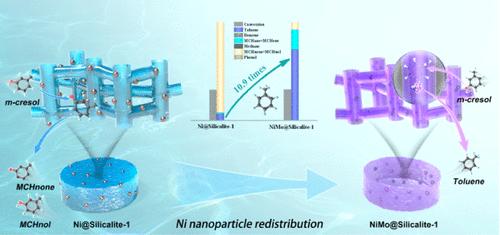mo改性Ni@Silicalite-1催化剂在气相间甲酚氢解反应中的甲苯选择性提高
IF 13.1
1区 化学
Q1 CHEMISTRY, PHYSICAL
引用次数: 0
摘要
生物基酚氢解制备高价值芳烃被认为是石油基芳烃的潜在替代策略,但广泛使用的镍基催化剂普遍存在芳烃产率较低的问题。在此,我们展示了一种策略,通过将Mo引入Ni@Silicalite-1 (Ni@S-1),驱动嵌入S-1外表层的Ni颗粒扩散到其更深的内部晶体中,形成均匀受限的NiMo双金属纳米颗粒(2-5 nm),具有丰富的氧空位。以气相间甲酚的羟基水解为例,NiMo@S-1在350℃条件下,在最小金属Ni负载下,羟基水解速率为501.9 μmol[间甲酚]·g[Ni] -1·s-1,羟基水解速率为480.3 μmol[甲苯]·g[Ni] -1·s-1,是迄今为止所披露的Ni基催化剂中羟基水解速率最高的。分析表明,这种诱导的约束结构使间甲酚通过垂直几何结构吸附在金属表面,从而产生沸石的形状选择效应,而NiMo@Silicalite-1的亲氧空位进一步加强了垂直取向的间甲酚通过羟基而不是苯基与活性位点相互作用,从而大大增强了期望的羟基水解过程。本文章由计算机程序翻译,如有差异,请以英文原文为准。

Boosting Toluene Selectivity over Mo-Modified Ni@Silicalite-1 Catalysts in Hydrogenolysis of Vapor-Phase m-Cresol
The hydrogenolysis of biobased phenolics into high-value arenes is considered as the potential alternative strategy to petroleum-based arenes, but the widely used Ni-based catalysts generally suffer from a poor arenes yield. Herein, we demonstrated a strategy by introducing Mo species into Ni@Silicalite-1 (Ni@S-1) to drive the diffusion of Ni particles embedded at the external surface layer of S-1 into its deeper internal crystals to form uniformly confined NiMo bimetallic nanoparticles (2–5 nm) with rich oxygen vacancies. As for hydroxyl hydrogenolysis of vapor-phase m-cresol as an example, NiMo@S-1 presented a remarkable toluene production rate of 480.3 μmol[toluene]·g[Ni]–1·s–1 with a hydroxyl hydrogenolysis rate of 501.9 μmol[m-cresol]·g[Ni]–1·s–1 at 350 °C under reported minimal metal Ni loading, suggesting the achievement of the highest hydroxyl hydrogenolysis rate over disclosed Ni-based catalysts by far. As analyzed, such induced confined structures enforce the m-cresol adsorbed onto the metal surface via the vertical geometry for the shape-selective effect of zeolites, and the oxygenophilic oxygen vacancies of NiMo@Silicalite-1 further strengthen the vertically oriented m-cresol to interact with active sites through the hydroxyl group rather than the phenyl group, thus greatly enhancing the desired hydroxyl hydrogenolysis process.
求助全文
通过发布文献求助,成功后即可免费获取论文全文。
去求助
来源期刊

ACS Catalysis
CHEMISTRY, PHYSICAL-
CiteScore
20.80
自引率
6.20%
发文量
1253
审稿时长
1.5 months
期刊介绍:
ACS Catalysis is an esteemed journal that publishes original research in the fields of heterogeneous catalysis, molecular catalysis, and biocatalysis. It offers broad coverage across diverse areas such as life sciences, organometallics and synthesis, photochemistry and electrochemistry, drug discovery and synthesis, materials science, environmental protection, polymer discovery and synthesis, and energy and fuels.
The scope of the journal is to showcase innovative work in various aspects of catalysis. This includes new reactions and novel synthetic approaches utilizing known catalysts, the discovery or modification of new catalysts, elucidation of catalytic mechanisms through cutting-edge investigations, practical enhancements of existing processes, as well as conceptual advances in the field. Contributions to ACS Catalysis can encompass both experimental and theoretical research focused on catalytic molecules, macromolecules, and materials that exhibit catalytic turnover.
 求助内容:
求助内容: 应助结果提醒方式:
应助结果提醒方式:


